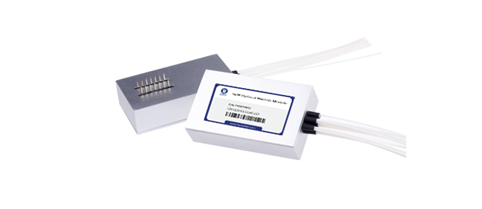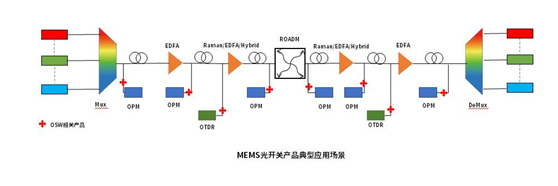This article will including:
What is optical switch?
Working principle of MEMS optical switch
Structure of MEMS fiber optic switch
MEMS optical switch VS Mechanical optical switch
The advantages of MEMS switch
The applications of MEMS fiber optic switch
The MEMS based optical switch in AON
What is optical switch?
Optical switch is a device that converts an optical signal from one optical channel to another optical channel within a certain range. It has one or more selectable transmission windows. Fiber optic switch is one of the core devices for optical cross-connection, optical add/drop multiplexing, network monitoring and automatic protection system.
Its implementation technologies are diverse, including: mechanical optical switches, thermo-optical switches, acousto-optic switches, electro-optical switches, magneto-optical switches, liquid crystal optical switches and MEMS optical switches. The traditional switch with electricity as the core is gradually unable to meet the demand for high-speed and large-capacity optical communication, which is why the all-optical switch appears in the market. Among them, MEMS optical fiber switches are widely used due to their small size, low power consumption, and good scalability.
Working principle of MEMS optical switch
What is MEMS? MEMS is shot for Micro-Electro-Mechanical System, which refers to a micro-device or system that can be mass-produced and integrate micro-machines, micro-actuators, signal processing and control circuits. The preparation process of micro-mechanical structures includes photolithography, ion beam Etching, chemical etching, wafer bonding, etc.
MEMS is driven by electronic technology, such as electrostatic attraction, electromagnetic force, electrostriction, and thermocouple. Among all the driving mechanisms of MEMS devices, the electrostatic attraction structure is the most widely used due to its simple preparation, easy control and low power consumption.
The MEMS optical switch is to engrave a number of tiny mirrors on the silicon crystal. The microarray is rotated by electrostatic force or electromagnetic force to change the propagation direction of the input light, thereby realizing the on and off function of the light path.

Generally speaking, MEMS based optical switch can be divided into two types in terms of spatial structure: 2D switches and 3D switches.

(a) 2-D (b) 3-D Source: researchgate.net
The rotating mirror of the 2D MEMS optical switch is monolithically integrated on the silicon substrate through surface micromechanical manufacturing technology, and the collimated light is connected to the designated output terminal through the rotation control of the micro mirror. When the micro mirror is horizontal, the light beam can pass through the micro mirror. When the micro mirror rotates perpendicular to the silicon substrate, it will reflect the light beam incident on its surface, so that the light beam can pass through the corresponding output port of the micro mirror. In the 3D MEMS optical switch, the micro mirror can rotate arbitrarily along two axes, so different angles can be used to change the output of the optical path. These arrays usually appear in pairs, and the input light reaches the first array mirror. It is reflected to the mirror surface of the second array, and then the light is reflected to the output port.
Structure of MEMS Fiber Optic Switch
Fiber optic switch is a multiport device. The port configurations include 2×2, 1×N, N×N. Optical switch with N×N ports is usually called OXC (optical cross connect). The structure of a MEMS-based 1×N optical switch is shown in Fig, which consists of a MEMS torsion mirror, a collimating lens and a multi-fiber pigtail. The MEMS mirror is usually assembled on a TO base, then the collimating lens is joint to the sub-assembly through the TO cap. Finally, the multi-fiber pigtail is actively aligned to the sub-assembly.

Structure of the 1×N MEMS optical switch
MEMS optical switch VS Mechanical optical
The working principle of mechanical optical switches is to redirect optical signals by physically moving optical fibers with the help of mechanical equipment. By moving the prism or directional coupler, the light at the input end will be directed to the desired output port. There are three main types of mechanical optical switches: one is to use a prism to switch the optical path technology, the other is to use mirror switching technology, and the third is to switch the optical path by moving an optical fiber.

MEMS optical switches are based on micro-electro-mechanical systems, which use optical micro-mirrors or optical micro-mirror arrays to change the direction of light beams to switch optical paths. The principle of MEMS optical switches is very simple. When the light is exchanged, the angle of the MEMS micro-mirror is moved or changed by the drive of the electrostatic force or the magnetic force, and the input light is switched to the different output terminals of the optical switch to realize the switching and on-off of the optical path.

The advantages of MEMS switch
The MEMS optical switch can realize the comprehensive remote control of the all-optical network, and has the main advantages of high integration, low power consumption and low cost. MEMS optical switches have the advantages of mechanical optical switches, such as low insertion loss, low crosstalk, low polarization sensitivity, high extinction ratio, high switching speed, small size and easy large-scale integration of waveguide switches. This will be the mainstream direction for the development of large-capacity switching optical network switches.

The applications of MEMS fiber optic switch
MEMS optical switches and the switch arrays have a wide range of applications in optical communications. Its application scope mainly includes: optical network protection switching system, light source control in optical fiber test, real-time monitoring system of network performance, optical device test, construction of switching core of OXC equipment, optical add/drop multiplexing, optical test, optical Sensing system, etc.

Applied in MCS (multicast switching optical switch)
MCS based on PLC technology and MEMS technology is a key component of the next generation reconfigurable optical add/drop multiplexing system (ROADM). Each functional unit is composed of M independent splitters and N independent MEMS optical switches, which provide connections from N upper (or lower) ports to M directions.
Applied in iODF (intelligent optical distribution)
Through optical switch cascade integration, it can be used in iODF to replace the traditional distribution frame in the industrial private network.
As the switching core of OXC (Optical Cross Connect) equipment
In the all-optical switching system, the optical switch is a key component of the OXC. Through optical switch cascade integration, it can be used in small OXC to meet the needs of industrial private networks and key lines in data centers.
Applied in optical performance monitoring
Integrated with TOF or OPM, combined with monitoring software, and through time division multiplexing OPM, it can be used to monitor the signal performance of the DWDM channel in the multi-core fiber in the optical cable. It is widely used in optical transmission network cable monitoring, ROADM network, DCI, etc.
Applied in optical cable monitoring
It is integrated with OTDR and combined with monitoring software to monitor the quality of multi-core optical fibers in the optical cable. It is widely used in PON network optical cable monitoring, optical transmission network optical cable monitoring, industry-specific network optical cable monitoring, etc.
Applied in optical fiber sensing
The main products used in Sensing field are 1x4 and 1x8 switch.
Applied in test instrumentation and factory automation
Applied in DWDM system
The MEMS based optical switch in AON
What is an all-optical network? AON is the abbreviation of All Optical Network, which means that the transmission and exchange process of the network is realized through optical fiber. This means that the data transmission process from the source node to the destination node is carried out in the optical domain, and the optical/electrical, electrical/optical conversion is only performed when entering and leaving the network. Since there is no need to implement electro-optical and photoelectric conversion, the network speed can be greatly increased. The main technologies of the all-optical network include optical fiber technology, SDH, WDM, optical switching technology, OXC, passive optical network technology and optical fiber amplifier technology.

Structure of AON
Among the various equipment of all-optical network, OXC and OADM (optical add-drop multiplexing equipment) are the core equipment technologies of all-optical network. Optical switches and optical switch arrays are the core technologies of OXC and OADM. The new optical switch made by MEMS technology is small in size, light in weight and low in energy consumption. It can be compatible with the manufacturing process of large-scale integrated circuits. It is easy to mass produce, integrate, and has low cost.
In recent years, as a MEMS optical switch manufacturer, HYC has focused on the research of large-channel multi-core fiber collimators, and has made achievements in the compact layout of high-density fibers. Now, we have the mass production capacity of 1×48 optical switches. HYC will officially release 1×64 MEMS optical switches or more channels.
https://www.hyc-system.com/Product/index_262